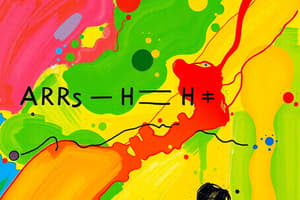Podcast
Questions and Answers
Which factor is LEAST likely to affect the rate of a chemical reaction?
Which factor is LEAST likely to affect the rate of a chemical reaction?
- Concentration of reactants
- Color of the reactants (correct)
- Temperature
- Presence of a catalyst
What happens to the rate of a reaction when the temperature is increased?
What happens to the rate of a reaction when the temperature is increased?
- It fluctuates randomly
- It decreases
- It increases (correct)
- It remains the same
What is a catalyst?
What is a catalyst?
- A substance that speeds up a reaction without being consumed (correct)
- A substance that changes the equilibrium of a reaction
- A substance that slows down a reaction
- A substance that is consumed in a reaction
If you increase the concentration of reactants, what generally happens to the reaction rate?
If you increase the concentration of reactants, what generally happens to the reaction rate?
What term describes the minimum amount of energy needed for a chemical reaction to occur?
What term describes the minimum amount of energy needed for a chemical reaction to occur?
According to collision theory, what two things must occur for a reaction to happen?
According to collision theory, what two things must occur for a reaction to happen?
How does increasing the surface area of a solid reactant typically affect the reaction rate?
How does increasing the surface area of a solid reactant typically affect the reaction rate?
Which of these is an example of a catalyst?
Which of these is an example of a catalyst?
If a reaction involves a solid and a gas, where does the reaction primarily occur?
If a reaction involves a solid and a gas, where does the reaction primarily occur?
What is another name for "rate of reaction?"
What is another name for "rate of reaction?"
Flashcards
Rate of reaction
Rate of reaction
The time or speed at which reactants convert into products.
Activation energy
Activation energy
The minimum energy required for a reaction to occur.
Effective collision
Effective collision
Reactions occur when reactant molecules collide effectively, possessing minimum energy and correct orientation.
Collision Theory
Collision Theory
Signup and view all the flashcards
Effect of Temperature
Effect of Temperature
Signup and view all the flashcards
Effect of Concentration
Effect of Concentration
Signup and view all the flashcards
Effect of Surface Area
Effect of Surface Area
Signup and view all the flashcards
Catalyst
Catalyst
Signup and view all the flashcards
Catalyst Action
Catalyst Action
Signup and view all the flashcards
Study Notes
Chemical Reactions
- A chemical reaction transforms one set of chemical substances into another, involving reactants and products.
- Reactants/reagents are the substances initially involved.
- Reactions are characterized by a chemical change, yielding products with different properties than reactants.
- The rate of a reaction varies depending on the factors involved during the reaction.
Rate of Reaction
- The Law of Conservation of Mass is applied to chemical reactions.
- Chemical reactions have evidence and expressions.
- Products of chemical reactions can be predicted.
- It is possible to distinguish the difference between reactants and products in chemical reactions.
- Types of chemical reactions can be identified.
- Reaction rate is the time or speed at which reactants convert into products.
- Reaction rate refers to the time frame or duration for a reaction to complete.
- Activation energy is the minimum energy required for a reaction to occur, without the required energy, a reaction will not take place.
- Collision Theory states that for a reaction between two particles to occur effectively, the particles must collide.
Measuring Reaction Rate
- Reactions occur when reactant molecules effectively collide, possessing minimum energy and correct orientation.
- Reaction rate is the speed at which a chemical reaction occurs; it can be quick or slow and can be altered.
- Reaction rate can be observed by monitoring the disappearance of a reactant or the appearance of a product over time.
- Chemists use two common methods to measure reaction rate: measuring the speed of product formation (indicated by color change and/or gas formation) and measuring the speed at which reactants are used up.
- Effective collisions require particles to collide with enough kinetic energy and the correct orientation to break existing bonds and form new ones.
- Collision Theory states that reactions between two particles require effective collisions between those particles.
Factors Affecting Reaction Rates Include:
- Temperature; raising the temperature increases molecular motion and collision likelihood, increasing the reaction rate. If you lower the temperature, the molecules are slower and temperatures drop which lowers there reaction rate.
- Nature of reactants.
- Physical state; reactions in heterogeneous mixtures are limited by the contact surface area between phases.
- Concentration which states that more substance in a system increases collision chances and reaction speed; less substance leads to fewer collisions and slower reactions.
- Catalyst; lower the activation energy and speed up the chemical reaction, remaining unchanged themselves.
Catalysts
- Catalysts speed up chemical reactions by lowering the activation energy without being consumed in the process.
- Factories use catalysts to make plastics and drugs with natural catalysts known as enzymes that play a role in digestion.
- Common types of catalysts are enzymes, acid-base catalysts, and surface catalysts.
- Examples of catalysts used everyday are Bakers adding vitamin C to increase the speed of gluten formation, eggs whipped in copper bowls that form a compound called copper conalbumin, adding papaya when cooking “Chicken Tinola” will help tenderize the chicken, marinating meat in pineapple juice will help tenderize the meat.
Studying That Suits You
Use AI to generate personalized quizzes and flashcards to suit your learning preferences.




